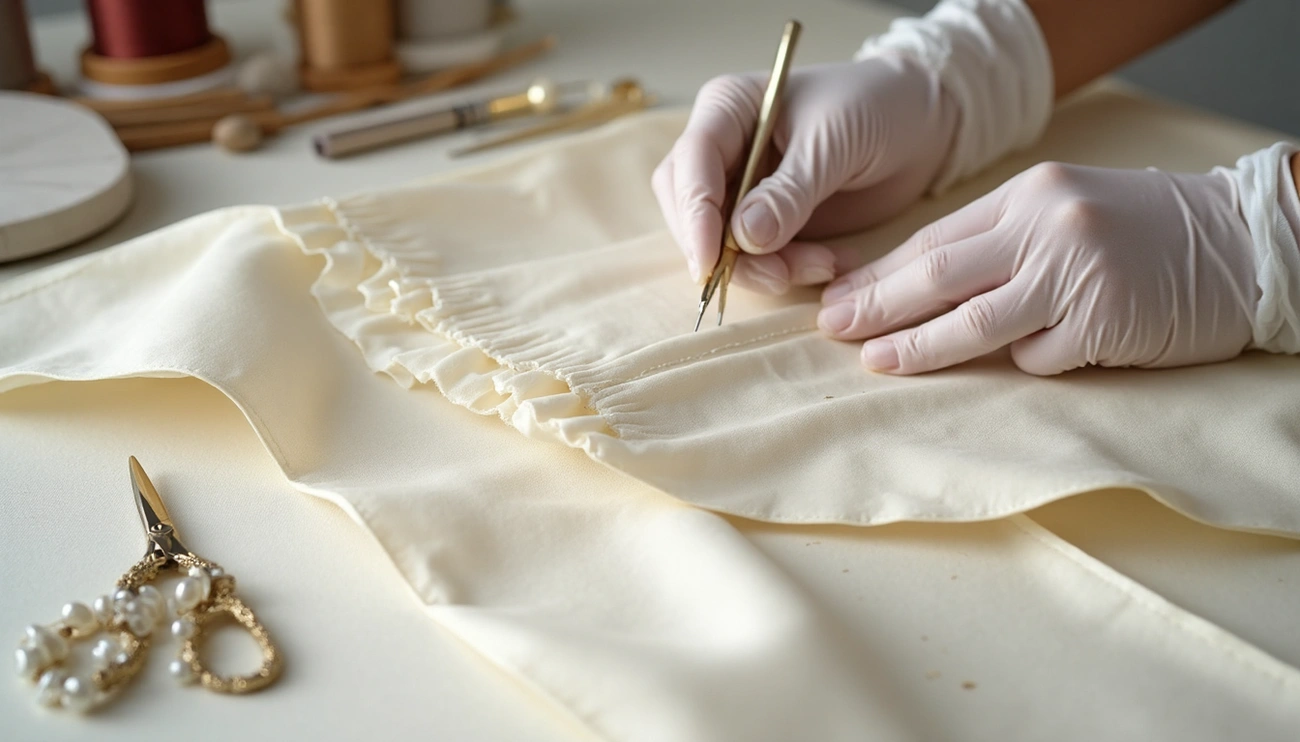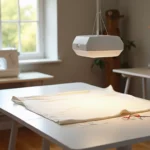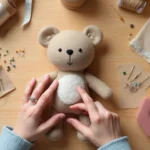Couture sewing techniques are high end garment construction methods used in Haute Couture. These techniques emphasize hand stitching, precise fit, fabric harmony, and finish. Unlike mass production, couture sewing involves no shortcuts, focusing on details like pleats, edge finishes, interfacing, and shaping to achieve luxury level results.

Beaditive Magnetic Pin Cushion with Drawer
Check Price
500PCS Sewing Pins for Fabric, Straight Pins
Check PriceUnderstanding Couture Sewing Techniques
The world of couture opens up a realm where sewing transcends mere garment construction to become an art form. At its core, couture represents a dedication to quality, precision, and unparalleled craftsmanship rarely found in today’s fast-fashion world.
What is couture sewing?
Couture, translated directly from French, simply means “sewing” or “dressmaking.” However, in practice, it represents much more. Couture sewing is often described as “sewing the way your grandmother sewed; it’s sewing without shortcuts.”
Traditionally, couture creates exclusive custom-fitted garments using high-quality fabrics with meticulous attention to detail. The process involves creating made-to-measure clothing tailored specifically for an individual’s measurements and body stance. Unlike mass-produced garments, couture pieces follow a personalized journey from conception to completion, with skilled artisans working diligently on each element.
How couture differs from regular sewing
The primary distinction between regular and couture sewing lies in the approach to time and technique. Regular sewing prioritizes efficiency and speed, while couture embraces a slower, more deliberate process. Consider these key differences:
- Couture involves extensive hand sewing rather than relying solely on machines
- Regular sewing uses standard-sized patterns; couture creates patterns on mannequins
- Couture requires multiple fittings throughout the construction process
- Regular sewing focuses on efficiency; couture emphasizes quality above all else
Moreover, couture employs specialized techniques rarely found in regular sewing, hand basting, thread tracing, and meticulous seam finishes that elevate the garment’s quality and longevity.
Essential Preparation Techniques
Preparation stands as the cornerstone of excellence in couture sewing. Before the first stitch is placed, couture practitioners invest significant time in foundational techniques that ultimately determine the quality of the finished garment.
Muslin making (toile)
A muslin, also known as a toile (pronounced “twal”), serves as a prototype or fitting version of a garment. This mock-up allows you to test and refine fit at an early stage, saving your quality fabric and increasing the likelihood of a successful final piece. I make muslins primarily when working with new patterns, especially those that are fitted or require precise proportions.
For couture work, it’s not always necessary to create the entire garment in muslin, focus on the parts critical to fit. As one expert notes, “My general rule is to cut out the pattern with just the parts I need to test for fit”. For stretch garments, use a fabric with similar properties rather than actual muslin, since regular cotton won’t accurately represent the final drape or fit.
Marking fabric accurately
In couture construction, matching seamlines rather than cut edges is essential, making accurate marking crucial. Claire Shaeffer, a couture expert, recommends two primary approaches: “baste around the pattern, or transfer the lines with dressmaker’s carbon first”. For precision marking, consider:
- Tailor’s tacks and thread tracing for delicate fabrics
- Chalk wheels for consistent marking across different fabrics
- Water-soluble pens for temporary, precise lines
Remember to test any marking tool on a fabric swatch first to ensure it disappears completely without leaving residue.
Choosing and applying sew-in interfacing
Sew-in interfacing is a hallmark of couture techniques, providing structure without fusing chemicals to fine fabrics. In fact, “silk organza is a lovely sew-in interfacing as it adds structure and stability while remaining light, breathable, and drape-able (it is very commonly used in couture sewing)”.
When selecting interfacing, match the weight to your fabric, lightweight for drapey fabrics, midweight for structured pieces. To apply sew-in interfacing, place it against the wrong side of your fabric and baste around the perimeter using long stitches, creating a temporarily unified layer that can be manipulated as one during construction.
Core Couture Hand Sewing Techniques

Fabric Scissors Tailor Sewing Shears
Check Price
Pressing Cloth for Ironing and Sewing 3 pcs Ironing Cloth to Protect Clothes
Check PriceThe heart of true couture lies in its distinctive hand techniques that create garments with unmatched quality and precision. These methods might seem time-consuming initially, yet they produce results that machine sewing simply cannot replicate.
Hand basting and thread tracing
Hand basting acts as a cornerstone of what is couture sewing techniques. Unlike pins which can distort fabric, basting temporarily holds layers together with remarkable precision. Thread tracing, meanwhile, transfers pattern markings to fabric using running stitches.
I’ve found several basting types particularly useful:
- Running basting – quick stitches ideal for matching complicated sections
- Diagonal basting – perfect for fabrics that shift (like velvet) or areas with gathers
- Slip basting – excellent for matching patterns or stripes
Thread tracing is often done with uneven stitches, creating longer stitches on the outside of the fabric. This technique makes pattern markings visible on both sides, something I consider absolutely magical for complex constructions.
Hand-picked zippers
Hand-picked zippers represent couture sewing at its finest. This technique creates a sturdy, elegant closure that won’t distort or pucker. The process involves stabilizing the zipper area with silk organza or interfacing, then attaching the zipper with a prickstitch, a variation of backstitch where the visible portion on the fabric’s right side is tiny, appearing like small beads along the zipper tape.
Couture hemming methods
For truly refined finishes, couture stitching techniques include several hemming options:
- Blind stitch – the most common, forming small Vs when worked from right to left
- Blind catchstitch – stronger and more elastic than regular blind stitch, forming concealed Xs
- Figure-eight stitch – rarely used but helpful for specialty applications
Advanced Details for a Polished Look
The final flourishes in couture construction transform good garments into extraordinary ones. These refined details showcase why couture sewing techniques remain valuable in an era of mass production.
Faced hems for curved edges
Curved hemlines pose unique challenges that traditional fold-up methods simply cannot address. A hem facing solves this elegantly by creating a separate pattern piece that follows the curve perfectly. Unlike standard hems that create puckers on curves, facings allow the hemline to maintain a smooth, professional appearance. This technique works exceptionally well for A-line skirts, circle skirts, and garments with dramatic curved edges. For best results, I interface the facing with lightweight material to add subtle structure and weight that improves how the garment hangs.
Couture waistbands and linings
Traditional waistbands often add unwanted bulk, yet couture approaches address this issue beautifully. A faced waistband, constructed from fashion fabric on the exterior and lighter lining fabric inside, reduces thickness while improving comfort. For truly refined finishes, adding petersham ribbon stays provides stability without sacrificing comfort. These internal structures prevent waistbands from collapsing or twisting through wear.
Likewise, linings deserve careful consideration. A hybrid approach, combining machine stitching for efficiency with hand finishing for control, offers the best balance. Instead of “bagging” linings entirely by machine, build in jump pleats along sleeve and bottom hems to allow movement without stress on the garment.
Trimming and edge finishes
Elevated edge treatments distinguish couture work from ordinary sewing. Hong Kong binding creates durable yet elegant seam finishes ideal for unlined jackets or formal wear. Alternatively, self-bound seams enclose raw edges with invisible fell stitches, concealing thread within the seam channel for a flawless finish.
Pleating and tucks in delicate fabrics
Delicate fabrics truly shine with thoughtfully placed pleats and tucks. For lightweight materials like silk or rayon, soft pleating creates beautiful movement and texture. Pin tucks, narrow, subtle folds stitched and pressed to one side, add sophisticated detail without overwhelming delicate fabrics. When working with curved tucks, proper marking on the right side ensures precise execution. Remember that bias-cut fabrics generally resist tucking successfully, so plan accordingly when designing with these elements.
Conclusion
Couture sewing techniques undoubtedly represent a commitment to excellence that elevates ordinary garments into extraordinary wearable art. Throughout this guide, we’ve explored the fundamental elements that distinguish couture work, from precise preparation methods to meticulous hand techniques that machines simply cannot replicate.
Mastering these techniques doesn’t happen overnight. Rather, they develop gradually through practice and patience. My journey into couture sewing began with small steps, implementing basic hand basting before attempting intricate hand-picked zippers or complex seam finishes. Eventually, these methods became second nature, significantly improving the quality of my projects.
While modern sewing often prioritizes speed and efficiency, couture reminds us that slowing down can actually yield superior results. The time invested in creating a proper muslin, thread tracing pattern markings, or finishing a hem by hand pays dividends in how a garment fits, feels, and lasts. Additionally, these techniques work equally well for creating everyday clothing or special occasion pieces.


